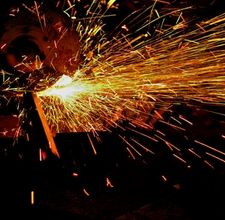How to Cutting Stainless Steel Sheets
Stainless steel is an attractive material for metal sculpture because of its superior corrosion resistance, flexibility and strength. You can create many interesting and durable works of art by cutting forms out of stainless steel sheet or plate, but depending on the thickness of the material you are cutting and the complexity of the shape, you may need to use some special tools and techniques to get the job done.
Cutting Thin-Gauge Steel
1. Cut thin stainless steel metal, between 25 and 15 gauge, with a pair of compound-action snips or shears, also called aviator's snips or tin snips. There are several different kinds of shears on the market--those that cut straight lines, those that cut curves to the left and those that cut curves to the right--so the type of cut you are making will determine the tool that you use. Certain snips are also designed for higher gauges, so be sure to choose a pair that will fit the thickness of your material.
2. Mark on your stainless steel sheet with a permanent marker or metal scribe where you want to make the cut.
3. Place the edge of the stainless steel all the way inside the jaws of the snips and cut along the line that you marked. Do not press down all the way on the snips, as this will make a jagged edge. Instead make a cut, open the snips, realign the metal in the bottom of the jaws and make another cut. Leather work gloves are recommended, as your hands may come in contact with the jagged steel edge as you cut, causing damage.
4. Use sandpaper to soften rough edges and remove dangerous burs once the cut is complete.

Cutting Medium-Gauge Steel
1. Cut steel between 16 gauge and 8 gauge with an electric jigsaw with a metal cutting blade or with a hacksaw.
2. Clamp your steel to a work bench or sawhorse. For thinner gauge metal you may want to use a piece of scrap wood as backing so that the stainless steel sheet does not bend during cutting.
3. Mark a line along which you wish to make your cutting with a permanent marker or scribe.
4. Put on a pair of safety glasses, leather gloves and earplugs. Fit your metal cutting blade into your hacksaw or jigsaw. Line the blade up with the edge of the steel sheet and activate the electric saw blade. The blade may heat up quickly, which will cause it to dull, so work slowly and take frequent breaks from cutting. Keep hands and fingers out of the path of the saw blade at all times and watch for flying debris. If the saw blade gets stuck at any point, immediately disengage the power and realign the blade to prevent damage to the saw.
5. Sand the rough edges and burs with sandpaper after you have allowed the piece to cool.
Cutting Thick-Gauge Stainless Steel
1. Cut steel thicker than 8 gauge with an angle grinder with an abrasiveness cutoff wheel that is designed for making rough cuts on stainless steel. Be sure to use a face shield, safety glasses, leather gloves and earplugs to protect yourself from flying debris, sparks and loud noise produced by the angle grinder.
2. Clamp your stainless steel plate down to a sawhorse or work bench in a well-ventilated area. Cutting with an angle grinder will produce a lot of sparks and smoke and should be done far away from any flammable substances.
3. Mark with a permanent marker or scribe where you would like to make your cut.
4. Fit your abrasiveness cutoff wheel onto your angle grinder and adjust the guard so that the blade is exposed. Release the safety and engage the motor before contacting the surface of the metal.
5. Cut through the metal plate slowly and try to aim any sparks away from your body and face. The angle grinder cannot make curved cuts, so you will have to approximate curves with rough, angled cuts and then grind them into curves later.
6. Let the cut cool for five to 10 minutes before touching it. If you have rough sections that must be shaped into curves, fit a grinding wheel only your angle grinder and stand down sharp edges, using the same precautions you would for cutting, until the shape is fully formed. Finally, sand any rough edges or burs when your work has cooled.
|
